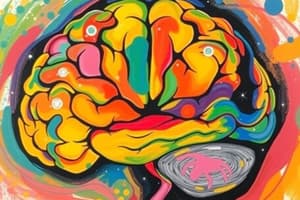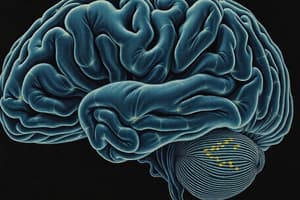Podcast
Questions and Answers
How does the brain communicate with the muscles?
How does the brain communicate with the muscles?
Through sending messages
What are examples of voluntary actions based on deciding what to do next?
What are examples of voluntary actions based on deciding what to do next?
Writing, talking, moving a chair, clapping at the end of a programme
What is the peripheral nervous system composed of?
What is the peripheral nervous system composed of?
Cranial nerves arising from the brain and spinal nerves arising from the spinal cord
What are the three major parts or regions of the brain?
What are the three major parts or regions of the brain?
Which part of the brain is responsible for thinking?
Which part of the brain is responsible for thinking?
Which part of the brain is responsible for receiving sensory impulses from various receptors?
Which part of the brain is responsible for receiving sensory impulses from various receptors?
What is the main function of the peripheral nervous system?
What is the main function of the peripheral nervous system?
What are examples of voluntary actions?
What are examples of voluntary actions?
How does the nervous system communicate with the muscles?
How does the nervous system communicate with the muscles?
Which region of the brain is responsible for integrating different inputs and outputs?
Which region of the brain is responsible for integrating different inputs and outputs?
Flashcards are hidden until you start studying
Study Notes
Brain-Muscle Communication
- The brain communicates with muscles through the nervous system, which transmits signals from the central nervous system (CNS) to muscles and glands.
Voluntary Actions
- Examples of voluntary actions include: walking, running, writing, and picking up objects, which are based on deciding what to do next.
- Voluntary actions involve conscious thought and intention, unlike involuntary actions like heartbeat and digestion.
Peripheral Nervous System
- The peripheral nervous system (PNS) is composed of nerves that connect the central nervous system (CNS) to the rest of the body.
- The PNS is responsible for transmitting information between the CNS and muscles, glands, and sensory receptors.
Brain Regions
- The three major parts or regions of the brain are:
- Cerebrum: responsible for thinking, perceiving, and controlling voluntary actions
- Cerebellum: coordinates muscle movements and balance
- Brainstem: connects the cerebrum and cerebellum to the spinal cord
Brain Functionality
- The cerebrum is responsible for thinking, problem-solving, and controlling voluntary actions.
- The cerebrum receives sensory impulses from various receptors, interpreting and processing visual, auditory, and other sensory information.
Peripheral Nervous System Function
- The main function of the peripheral nervous system is to transmit information between the CNS and the rest of the body.
Integrating Inputs and Outputs
- The cerebrum is responsible for integrating different inputs and outputs, allowing for coordinated responses to internal and external stimuli.
Studying That Suits You
Use AI to generate personalized quizzes and flashcards to suit your learning preferences.




